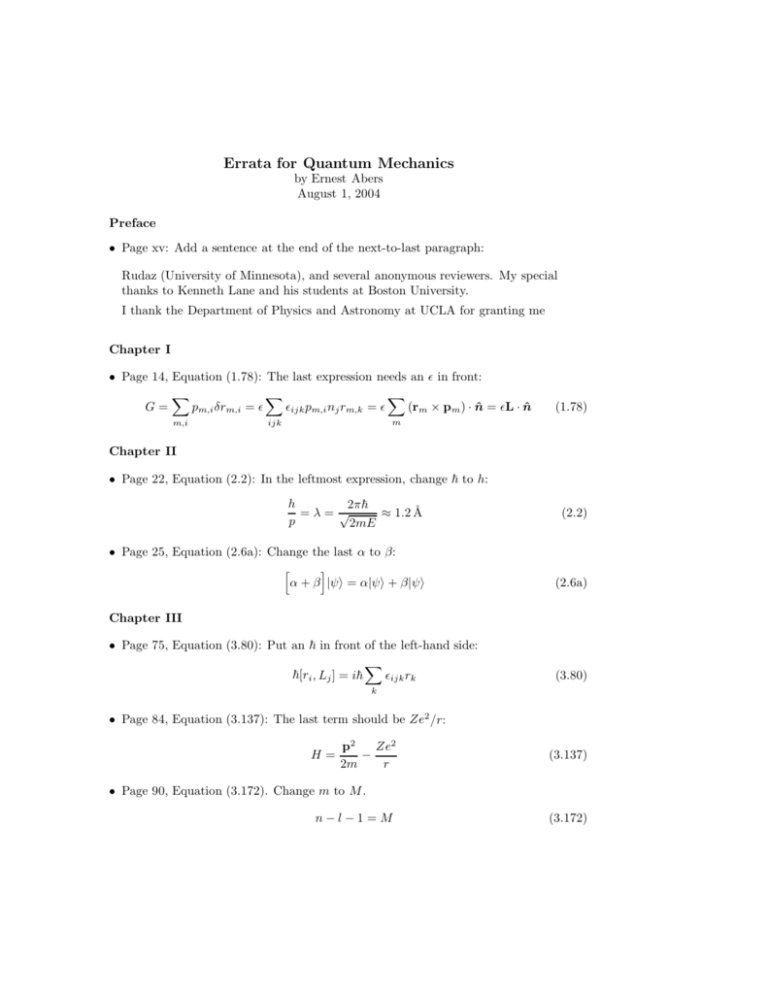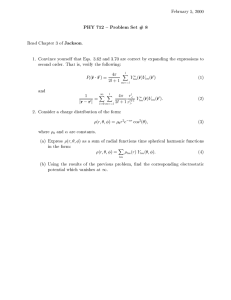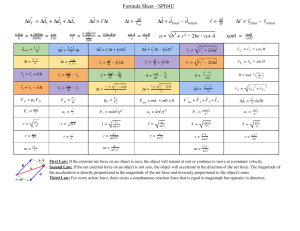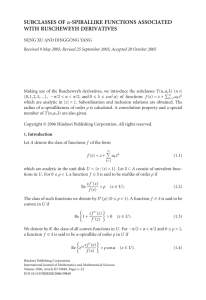Errata for Quantum Mechanics
advertisement

Errata for Quantum Mechanics by Ernest Abers August 1, 2004 Preface • Page xv: Add a sentence at the end of the next-to-last paragraph: Rudaz (University of Minnesota), and several anonymous reviewers. My special thanks to Kenneth Lane and his students at Boston University. I thank the Department of Physics and Astronomy at UCLA for granting me Chapter I • Page 14, Equation (1.78): The last expression needs an in front: X X X G= pm,i δrm,i = ijk pm,i nj rm,k = (rm × pm ) · n̂ = L · n̂ m,i (1.78) m ijk Chapter II • Page 22, Equation (2.2): In the leftmost expression, change ~ to h: h 2π~ =λ= √ ≈ 1.2 Å p 2mE • Page 25, Equation (2.6a): Change the last α to β: h i α + β |ψi = α|ψi + β|ψi (2.2) (2.6a) Chapter III • Page 75, Equation (3.80): Put an ~ in front of the left-hand side: X ~[ri , Lj ] = i~ ijk rk (3.80) k • Page 84, Equation (3.137): The last term should be Ze2 /r: H= p2 Ze2 − 2m r (3.137) • Page 90, Equation (3.172). Change m to M . n−l−1 =M (3.172) 2 Quantum Mechanics Chapter IV • Page 122, just above Equation (4.105), insert “solutions” between “the” and “to”: The eigenstates are linear combinations of |1, −1/2i and |0, 1/2i. The eigenvalues are the solutions to the characteristic equation: • Page 126, third paragraph, third line: change 1/2f to 1/2: Unless l = 0, there are two states with m = l − 1/2. One linear combination will be in the j = l + 1/2 ladder. The remaining one must be the top of a new ladder, this time with j = l − 1/2. The number of states in these two ladders adds • Page 131, Problem 4.2, part (b): Change the superscript j to 1: X † Uam D(1) (J¯i )mn Unb = J¯i ab mn • Page 132, Problem 4.4, part (c). The last equation on the page should be changed to m± ψ(r) = R± (θ, φ) El (r)Yl Chapter V • Page 140, line below Equation (5.6): Change g(a) to g(): For a one-parameter subgroup of continuous symmetries g() = exp(−iG), • Page 161, Equation (5.123): Divide the exponent by ~: U (tf , ti) = e−iH(tf −ti )/~ (5.123) Chapter VII • Page 203, Equation (7.8): In the first line change Eon to Eno (twice): (H − Eno + Eno − Ho ) |ψn i = H 0|ψni (Ho − Eno ) |ψn i = (∆n − H 0) |ψni (7.8) • Page 205, second bulleted paragraph, seventh line: Change “so” to “but”: Two states in one of these ladders will have the same unperturbed energy, but we • Page 214, Equations (7.69) to (7.70): Change the subscript “3” to “D”: HD = − 1 ∇2V (r) 8m2 ED = α4 m δl0 2n3 (7.69) (7.70) ERRATA • Page 226. Equation (7.133): Delete the subscript “i” (four times): 2 Z p σe2 ψ100(r) − ψ100(r) d3r = E1o (σ) = σ2 E1o 2m r 3 (7.133) Chapter VIII • Page 270, Equation (8.40): change the left-hand side to f (1) (Θ): Z 1 (1) f (Θ) = − eiq·rU (r) d3r 4π Z 1 Z Z 1 ∞ 2 1 ∞ iqr cos θ = r dr e U (r)d cos θ = − r sin(qr)U (r)dr 2 0 q 0 −1 • Page 270, Equation (8.39), replace r by r0 inside the integral. Z 0 0 1 (1) f (θ, φ) = − ei(k−k )·r U (r0) d3r0 4π (8.40) (8.39) • Page 273, Equation (8.56): In the second line, second term inside the large parentheses, move the asterisk from χ to φ. In the fourth line, first expression, second term inside the parentheses, change plus to minus: Z kσtot ∗ ∂χ ∗ ∂φ = −Im φ ( ( ) + χ ) r2dΩ (2π)3 ∂r ∂r Z ∂χ ∂φ∗ = −Im φ∗( ) − χ( ) r2dΩ ∂r ∂r Z ∂ψ ∂φ∗ = −Im φ∗ ( ) − ψ( ) r2dΩ ∂r ∂r Z Z = −Im (φ∗ ∇ψ − ψ∇φ∗ ) · n̂dS = −Im φ∗ ∇2 ψ − ψ∇2φ∗ d3r Z 1 = −Im φ∗ (r)U (r)ψ(r)d3 r = Im f(0) (8.56) 2π2 • Page 277, Equation (8.80), in the first line, in the numerator of first factor, change 2l + l to 2l + 1: Z 2l l! 2l + 1 X n ρn 2n(n!)2 1 Al ρl i Pn(z)Pl (z)dz = (2l + 1)! 2 n! (2n)! −1 n (8.80) l l 2 l ρ 2 (l!) =i l! (2l)! • Page 280, Equation (8.97): Change the last r to r0. Move the asterisk to after the second Ylm factor. 4 Quantum Mechanics • Page 280, Equation (8.98) Change the arguments of the first Ylm to (θ0 , φ0). • Page 280, Equation (8.99) second line, change n̂ to θ0 , φ0, and change n̂z to 0, φ: 4π X l m φk0 (r0 ) = i Yl (θ, φ)Ylm (θ0 , φ0)∗ jl (kr0) (8.97) 3 (2π) 2 l,m and ψk (r0 ) = 4π X l m 0 0 ∗ m i Yl (θ , φ ) Yl (0, φ)Rl (r0 ) 3 (2π) 2 l,m (8.98) Therefore the scattering amplitude is Z X f(θ, φ) = −4π (−i)l Ylm (θ, φ)∗ Ylm (θ0 , φ0)jl (kr0 ) l,m 0 × U (r ) X i l0 Ylo0 (θ0 , φ0)Rl0 (r0)Ylo0 (0, φ) ! r02dr0dΩ0 (8.99) l0 Z =− ∞ 0 " X 0 0 0 # (2l + 1)jl (kr )U (r )Rl (r )Pl (cos θ) r02dr0 l • Page 280, Equation (8.100) On the left, k should be the denominator of all the rest, not just δl : Z ∞ eiδl sin δl jl (kr)U (r)Rl (r)r2 dr (8.100) =− k 0 • page 280, last sentence, replace “in that number” by “in that limit”. • Page 284, Problem 8.1, in the line just following the unnumbered displayed equation, on the right-hand-side of the in-line equation, remove the middle vertical line: where ρ(r) = ψ100(r)2 , the probability distribution of the bound electron. • Page 287, Reference [3], Replace the comma after K by a period: [3] K. Gottfried, Appendix D. Quantum Mechanics, Volume I, Benjamin, 1966. See also Chapter IX • Page 288, in the subsubsection heading just below the 9.1.2 subsection heading, change Transistions to Transitions. • Page 289, Equation (9.10), second line, 4m2 in denominator should be just m2 . i(ω −ω)t 2 ba − 1 2 e Pb (t) ≈ |Vba | ωba − ω (9.10) 2 sin(|ω | − ω)t/2 α 2 2 ba = 2 Ao ψb p · ε̂e−ik·r ψa m |ωba| − ω ERRATA 5 • Page 290, Equation (9.16), replace 4m2 by m2 and 8π2 by 4π2. P (t) −→ t→∞ α 4π2 ψb p · ε̂e−ik·r ψn 2 t ρ(ω ) ba 2 m2 ωba (9.16) • Page 291, Equation (9.17), replace 4m2 by m2 and 8π2 by 4π2. Γb = 2 α 4π2 p · ε̂e−ik·r ψn ρ(ω ) ψ ba b 2 m2 ωba (9.17) • Page 291, in the line just above Equation (9.21) change θ to cos2 θ. In Equation (9.21) change cos θ to cos2 θ: where θ is the angle between the constant vector r and the polarization. If the radiation is unpolarized and isotropic, just replace cos2 θ by its average value: Z 1 1 cos2 θ → cos2 θ dΩ = (9.21) 4π 3 • Page 292, change the text between Equations (9.25) and (9.26) to read: “Then aba(ω) is related to Aba (ω) by” • Page 294: There is no Equation (3.33). Latex just skipped an equation number! I don’t really understand how this could have happened, but it is under control. • Page 294, in the text just below Equation (9.30), change “has an inverse” to “exists”: Even though the operator H − ω has no inverse for positive real ω, G(ω) exists for real ω and any finite real . • Page 295, in the sentence above equation (9.42), change the first (9.40) to (9.39): From equations (9.39) and (9.40) it also follows that • Page 301, just before the “Optical Theorem” heading, add “The relativistically correct forms of Equations (9.71) and (9.72) are obtained replacing m2 by ωa2 .” • Page 304, Equation (9.90): Change the left hand side to hφb| T |φa i: hφb | T |φa i = δ3 (K0 − K) φb T̄ φa (9.90) • Page 304, Equation (9.93): The integrals should end in d3k10 d3k20 and d3K 0 d3k0: Z 2 Γ̄ = 2π |Tba | δ (ωa − ωb )d3k10 d3k20 Z 2 = 2π δ3 (K0 − K)T̄ba δ (ωa − ωb )d3K 0 d3k0 (9.93) Z 2 V ≈ 2π T̄ba δ (ωa − ωb)δ3 (K0 − K) d3K 0 d3k0 (2π)3 6 Quantum Mechanics • Pages 304-305, In equations (9.90) through (9.95) change T 0 to T everywhere. • Page 306, Equation (9.103). In the first line exchange r1 and r2 in the exponent. In the second line change the sign of the exponent: Z 0 0 1 1 0 Hba,2 = ± V (|r1 − r2 |)ei(k2−k1 )·r2 ei(k1 −k2 )·r1 d3r1 d3r2 2 (2π)6 Z (9.103) 1 1 i(k+k0 )·r 0 3 V (r)e =± δ (K − K ) d r 3 2 (2π)3 • Page 307: In equation (9.104) delete the delta function δ3 (K − K0 ) in the first line. Change T to T̄ everywhere in (9.104) and (9.105). And replace p by k in these and the next two equations: Z 0 1 T¯direct (ωa , θ, φ) = V (r)ei(k−k )·r d3r 3 (2π) (9.104) e2 e2 α = = = 2π2q2 4π2 k2(1 − cos θ) 8π2 k2 sin2 (θ/2) T̄exchange (ωa , θ, φ) = T̄direct (ωa , π − θ, φ + 2π) = e2 16π2k2 cos2 (θ/2) = α (9.105) 8π2 k2 cos2 (θ/2) 2 2 dσ 1 1 α2 α2µ2 1 1 4 2 = = (2π) µ ± ± 2 2 dΩ 64π4 k4 sin (θ/2) cos2 (θ/2) 4k4 sin (θ/2) cos2 (θ/2) 1 α 2 µ2 1 1 1 = + ± 2 4k4 cos4 (θ/2) sin4(θ/2) sin2 (θ/2) cos2(θ/2) (9.106) dσ 1 α 2 µ2 1 1 1 = − (9.107) + dΩ unpolarized 4k4 sin4 (θ/2) cos4(θ/2) sin2 (θ/2) cos2 (θ/2) • Page 312, Equation (9.132): On the left, change ω0 to ωa0 . On the right, change the denominator to ωb − ωa . In Equation (9.133) replace ω by ωb. In the text below Equation (9.134) delete “with ωa0 = Re ω0 above”: 0 ωa0 = ωa + Haa + Re X b6=a −π X 0 2 |Hba | 1 +··· ωb − ωa 0 2 |Hba | δ (ωb − ωa) = −Γ/2 (9.132) (9.133) b6=a G(ω)aa = 1 ω − ωa0 + iΓ/2 Evidently T (ω) has a singularity in the lower half plane, (9.134) ERRATA 7 • Page 314 just below Equation (9.142) change “closer to” to “farther from”: which is farther from unity than the same probability 0 0 • Page 315, Equation (9.148) change absHba to |H|ba : 0 0 d 0 2 2(ωa − ωb ) sin(ωa − ωb )t | |aba(t)|2 → |Hba 0 2 dt (ωa − ωb) + Γ2/4 (9.148) Chapter X • Page 340, Figure 10.1. The arcs should form a circle, whose center is at the base of the arrow. [Some glitch is a graphics program printed some of the arcs in the wrong place.] • page 355, Reference [14], change Tycho to Tycko, here and in the index. [14] R. Tycko, Phys. Rev. Letters 58 (1987) 2281. Chapter XI • Page 365, Equations (11.57) and (11.57): In both equations change 4pi to 4π. Z ∂A 1 (4π)1/2 E(r, t) = − i √ ω a(k, t) − a† (−k, t) eik·r d3k (11.57) = ∂t (2π)3/2 2ω and B(r, t) = ∇ × A = − (4π)1/2 i (2π)3/2 Z 1 √ ωn̂ × a(−k, t) + a† (k, t) e−ik·r d3k 2ω (11.58) • Page 377, Equation (11.119). Replace 25 by 26, and therefore replace 9.49 × 10−31 by 1.87 × 10−30 and replace 1.44 × 10−15 by 2.84 × 10−15. The the next line needs to read “The lifetime is 3.53 × 1014 seconds, over 100,000 centuries....”. Also, delete Equation (11.117e) – there is nothing there: The J = 0 state is 1 1 1 1 , − − − , 2 2 2 2 √ 2 Γ= M =0 26 13 3 α gp (m/M )3 m = 1.87 × 10−30eV = 2.84 × 10−15 sec−1 34 (11.117d) (11.109) The lifetime is 3.53 × 1014 seconds, over 100,000 centuries. It should be clear • Page 403 Problem 11.5: Delete the sentence “What is the width of these components of the Lyman-β line?” Compute the rate for the spontaneous decay of a 3P state to the 1S state. (Here you can ignore spin—these are electric transitions.) 8 Quantum Mechanics Chapter XII • Page 409, Equation (12.14c): Change x to z: z0 = z (12.14c) • Page 410, Equations (12.20): The exponents should be boldface: ¯ R̄ = e−iθn̂·J (12.20a) B̄ = e−iωn̂·K̄ (12.20b) • Page 416, Equation (12.67): Change the sign of the last term inside the large parentheses from minus to plus: 1 d2 l(l + 1) − α2 ωα ω2 − m2 − + + u(r) = 0 (12.67) 2m dr2 2mr2 mr 2m Chapter XIII • Page 439, Equations (13.9) through (13.11): Change pi to π four times: Z 1 Ψ(r) = eip·ra(p)d3p (2π)3/2 (13.9) Then Ψ† (r)|i = 1 (2π)3/2 Z e−ip·ra† (p)|i d3p = 1 (2π)3/2 Z e−ip·r|pi d3 p This is a one-particle state whose wave function is Z 0 † 1 0 ψ(r ) = r Ψ (r) = e−ip·r hr0| pi d3p = δ3 (r − r0) (2π)3/2 (13.10) (13.11)











